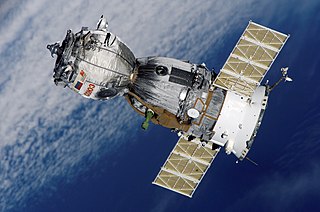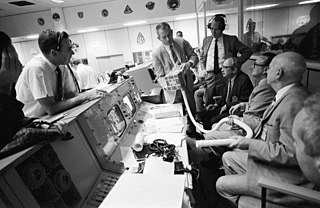
Deep Space 1 (DS1) was a NASA technology demonstration spacecraft which flew by an asteroid and a comet. It was part of the New Millennium Program, dedicated to testing advanced technologies.

A robotic spacecraft is an uncrewed spacecraft, usually under telerobotic control. A robotic spacecraft designed to make scientific research measurements is often called a space probe. Many space missions are more suited to telerobotic rather than crewed operation, due to lower cost and lower risk factors. In addition, some planetary destinations such as Venus or the vicinity of Jupiter are too hostile for human survival, given current technology. Outer planets such as Saturn, Uranus, and Neptune are too distant to reach with current crewed spacecraft technology, so telerobotic probes are the only way to explore them.

Spaceflight is ballistic flight into or through outer space. Spaceflight can occur with spacecraft with or without humans on board. Yuri Gagarin of the Soviet Union was the first human to conduct a spaceflight. Examples of human spaceflight include the U.S. Apollo Moon landing and Space Shuttle programs and the Russian Soyuz program, as well as the ongoing International Space Station. Examples of unmanned spaceflight include space probes that leave Earth orbit, as well as satellites in orbit around Earth, such as communications satellites. These operate either by telerobotic control or are fully autonomous.

Paul William Richards is an American engineer and a former NASA Astronaut. He flew aboard one Space Shuttle mission in 2001.
The design of spacecraft covers a broad area, including the design of both robotic spacecraft, and spacecraft for human spaceflight.

Space Technology 5 (ST5) of the NASA New Millennium program is a test of ten new technologies aboard a group of microsatellites. Developed by NASA Goddard Space Flight Center, the three small spacecraft were launched separately from the belly of a Lockheed L-1011 aboard the Pegasus XL rocket, on 22 March 2006. One technology involves antennas that were designed by computers using an evolutionary AI system developed at NASA Ames Research Center. The ST5 on-board flight computer, the C&DH system, is based on a Mongoose-V radiation-hardened microprocessor.

An electrically-powered spacecraft propulsion system uses electrical energy to change the velocity of a spacecraft. Most of these kinds of spacecraft propulsion systems work by electrically expelling propellant at high speed, but electrodynamic tethers work by interacting with a planet's magnetic field.

James Robert Thompson Jr., known as J.R. Thompson, was the fifth director of the NASA Marshall Space Flight Center located in Huntsville, Alabama. He served as director from September 29, 1986, to July 6, 1989. Thompson also served as NASA's deputy director from July 6, 1989, to November 8, 1991.

The Submillimeter Wave Astronomy Satellite (SWAS) is a NASA submillimeter astronomy satellite, and is the third spacecraft in the Small Explorer program. It was launched on December 6, 1998 (UTC), from Vandenberg Air Force Base aboard a Pegasus XL rocket. The telescope was designed by the Smithsonian Astrophysical Observatory and integrated by Ball Aerospace, while the spacecraft was built by NASA's Goddard Space Flight Center. The mission's principal investigator is Gary J. Melnick.

The Space Communications and Navigation (SCaN) program places the three prime NASA space communications networks, Space Network (SN), Near Earth Network (NEN), and the Deep Space Network (DSN), under one Management and Systems Engineering umbrella. It was established in 2006. It was previously known as the Space Communications & Data Systems (SCDS) Program.

Goddard Space Flight Center is NASA's first, and oldest, space center. It is named after Dr. Robert H. Goddard, the father of modern rocketry. Throughout its history, the center has managed, developed, and operated many notable missions, including the Cosmic Background Explorer, the Hubble Space Telescope, the Tracking and Data Relay Satellite System (TDRSS), the Lunar Reconnaissance Orbiter, and the Solar Dynamics Observatory.

Aerospace engineering is the primary field of engineering concerned with the development of aircraft and spacecraft. It has two major and overlapping branches: aeronautical engineering and astronautical engineering. Avionics engineering is similar, but deals with the electronics side of aerospace engineering.

Swales Aerospace was an employee-owned, small business aerospace engineering firm. The company offered a full range of aerospace engineering services. It was the global leader in the development and manufacture of two-phase thermal solutions for spaceflight applications, and it was a small satellite mission provider. In 2007, it was acquired by Alliant Techsystems.

A ground segment consists of all the ground-based elements of a spacecraft system used by operators and support personnel, as opposed to the space segment and user segment. The ground segment enables management of a spacecraft, and distribution of payload data and telemetry among interested parties on the ground. The primary elements of a ground segment are:

The Near-Earth Asteroid Scout is a planned mission by NASA to develop a controllable low-cost CubeSat solar sail spacecraft capable of encountering near-Earth asteroids (NEA). The NEA Scout will be one of 13 CubeSats to be carried with the Orion EM-1 mission into a heliocentric orbit in cis-lunar space on the maiden flight of the Space Launch System (SLS) scheduled to launch in 2020. The most likely target for the mission is 1991 VG, but this may change based on launch date or other factors. After deployment in cislunar space, NEA Scout will perform a series of lunar flybys to achieve optimum departure trajectory before beginning its two-year-long cruise.

Magnetometer (MAG) is the name of an instrument suite on the Juno orbiter for planet Jupiter. The MAG instrument includes both the Fluxgate Magnetometer (FGM) and Advanced Stellar Compass (ASC) instruments. There two sets of MAG instrument suites, and they are both positioned on the far end of three solar panel array booms. Each MAG instrument suite observes the same swath of Jupiter, and by having two sets of instruments, determining what signal is from the planet and what is from spacecraft is supported. Avoiding signals from the spacecraft is another reason MAG is placed at the end of the solar panel boom, about 10 m and 12 m away from the central body of the Juno spacecraft.

CAESAR is a proposed sample-return mission to comet 67P/Churyumov–Gerasimenko. The mission was proposed in 2017 to NASA's New Frontiers program mission 4, and on 20 December 2017 it was one of two finalists selected for further concept development.

















